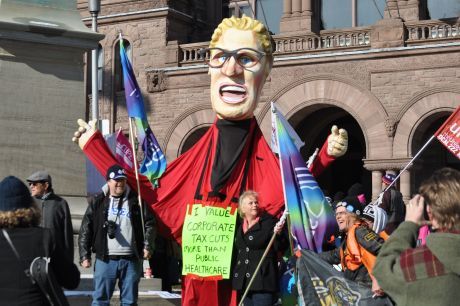Columns
You are here
Austerity in Ontario

April 30, 2015
A huge fight is brewing between the provincial government, teachers and the Ontario public sector.
The Liberal government tried to put a progressive gloss on its campaign in the last provincial election. The NDP chose not to rally around issues such as a $14 minimum wage and voters turned away from them, particularly in Toronto where they lost three seats. This led to a majority Liberal government with Kathleen Wynn as premier.
Budget cuts
The true colours of the Liberal Party are now being seen and it is pressing hard to deliver a “balanced budget” by 2017, doing away with the deficit in a ruthless manner. This is the method and the mantra of neo-liberals all over the globe, and in this province the government wants to cut $2 billion from the budget this year. This is of course on the backs of the people of the province through cuts to services, and to those who work for the province through layoffs, privitization and wage freezes.
Along with other sectors this will have a devastating effect on health care spending, particularly effecting hospitals in the province. The Ontario Health Coalition has is pointed this out in recent policy papers and announcements of drastic changes. The Ontario Nurses Association has shown that over 60,000 nursing hours have already been lost.
Teachers
The provincial government is also taking on the Ontario Public Service Employees Union (OPSEU) and the teachers unions. The Ontario Secondary School Teachers Federation (OSSTF) has already called for rolling strikes after months of negotiations that have gone nowhere. Teachers in Durham and Sudbury have already struck and others are prepared to go out. They are concerned about rising class sizes which will have a major effect on the quality of education and of course will lead to job losses.
Teachers have taken job action in British Columbia because of the deterioration in education. Smaller class sizes have been shown to improve learning. I remember very well classes with over forty students when I was in public school and we don’t want to go back to those days if we are interested in quality education and the attention that individual students deserve. The teachers are fighting for the community. They went into the profession because they care about the students and that’s why they are striking.
Public sector and privatization
The same is happening to public sector workers who are employed by the government. Spending is increasing by only 1.4 per cent, which is really a freeze when inflation is taken into account. OPSEU has been calling rallies and demonstrations pointing out the effects on public services. There is the possibility of an all out strike later in the year and the effect on the community has been front and centre in their campaign.
The other piece of the neo-liberal agenda that we are seeing is the privatization of public assets, a hallmark of neo-liberal governments. The Wynn Liberals intend to sell off their majority share in Hydro One, which will line the pockets of private business and undoubtedly lead to higher costs for the consumer. CUPE is taking this on. Public ownership must be maintained and CUPE is fighting this with strong community support. Once an asset like this is gone, it’s gone for good.
We have also just been through two tough strikes by education workers at the University of Toronto and York. Teaching assistants and contract workers took on both universities because of the impact of the cuts to education. They felt their students were feeling the brunt of the attacks and of course their working conditions and wages were being affected as well. These were hard fought strikes that made gains. We have to continue to provide the solidarity necessary to push back and win when public sector workers fight back.
Section:










